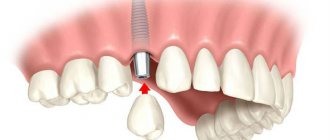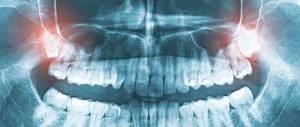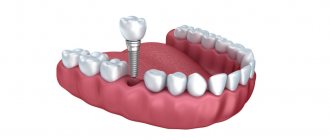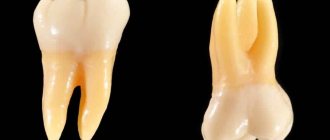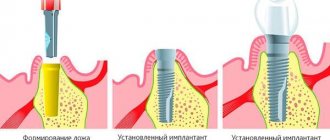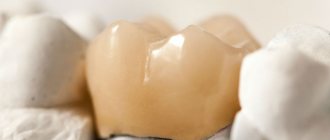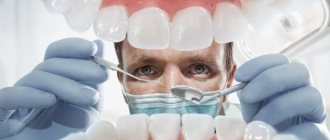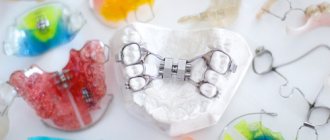- How the Mark Ross apparatus is installed and works
- Fixed plate installation process
- Advantages and effectiveness of a plate for maxillary expansion in children
- Why is it better to go to the Aesculapius clinic?
Plates for expanding the jaw for children are special dental devices for correcting the bite and straightening the dentition. The device is used in early childhood and is not removed throughout the treatment. Plates are complex orthodontic structures of different appearances, which are made according to individual impressions of the child’s jaw. Treatment with the apparatus of Dr. Marco Ross shows good results and effectively normalizes the shape of the upper jaw.
How to install and operate the Marco Ross apparatus
A non-removable plate for expanding the upper jaw for children is a plastic base connected to metal arches of various configurations. A screw with maximum potential for expanding the upper dentition is built into the product. It is this element that is the force that allows the plate to work to expand the child’s upper jaw. A plate is fixed to the upper jaw on the baby’s temporary molars and canines. For the former, with the help of orthodontic rings and metal arches, and for the latter, with dental material.
Derichsweiler apparatus
The design is a mechanism that consists of main rings and corrective arcs. The support rings are fixed on the back teeth, where there is an attached lock on which the arches are attached.
They converge near the palatal arch, where the activator is located. This is a screw that transmits systematic pressure to the palate. The palatal suture expands, resulting in the jaw becoming wider. The gap that is formed when the palate opens is filled after some time with other soft tissue.
The device is prescribed for narrowing of the jaw arch during the first mixed bite. If the disease has formed in the permanent dentition, then the unit will have the least result, because it cannot cope with the hardened palatal suture. The device has its advantages:
- The dental expander has a plastic effect during correction, and there is no discomfort while wearing.
- The device cannot be removed independently, so correction is carried out in a minimum period of time.
- The device does not damage delicate gum tissue.
Like any device, the design has disadvantages. On the first day of wearing, maximum salivation and impaired pronunciation of words are noticed. Sometimes the surface of the tongue is injured. It is impossible to adjust the device yourself; to do this you need to visit a dentist.
Advantages and effectiveness of a plate for expanding the upper jaw in children
The huge advantage of orthodontic plates is that, despite their simplicity, they have a fairly wide range of uses at a low cost. A jaw expansion plate is recommended in cases such as:
- Narrowed upper teeth.
- There is not enough space for the upper and lower incisors.
- Malocclusion due to narrowing/shortening of the upper jaw.
- Difficulty in nasal breathing and non-closure of lips.
- Problems with diction associated with underdevelopment of the upper dentition.
At the same time, a plate for expanding a child’s jaw has a number of advantages compared to other methods:
- Treatment does not require the child's active cooperation.
- A fixed device cannot be forgotten or lost.
- The space for the eruption of molars is prepared.
- The likelihood that children will need braces in the future is greatly reduced.
Expanding the upper jaw in children is an effective method to take care of your baby’s oral health. Moreover, the procedure is completely safe and reliable, but only if carried out by professionals.
Removable plate
The device is intended for the treatment of pathologies of mixed dentition. Expansion arches are used mainly for children from 6 to 11 years old. Characteristic design features:
- The device is used for uneven narrowing of the teeth line.
- The construction is made on a personal basis; for this purpose, casts of the jaws are made.
Expansion plates are a device that consists of a base plate and a special screw. The plates are made of hard plastic and follow the relief of the palate. The dental expander is formed taking into account sectoral cuts connected by special springs, which increase the pressure on the jaw bone. Depending on the problem, the activator screw is located in the middle of the plate or in the sector lobe.
When a certain area of the jaw is narrowed, a screw is placed on the plate from the side of the pathology. To ensure that the molars are adjusted at the same time, vestibular metal arches are installed on the device. The main advantages of the device:
- The spacer has a complex effect; after use, the arches expand and the frontal section is leveled.
- The design is often used in dentistry because it has affordable care.
- Hygienic cleaning is carried out by the child; if desired, the structure can be removed.
- The adaptation period is painless, because the device is removed with your own hands, the cheeks on the inside are not injured.
- It is easy to insert the structure back.
The expansion plate has disadvantages. Some clients take a long time to get used to it due to its volume. Some people experience vomiting when wearing orthodontic appliances. The plate is replaceable, so constant monitoring is required when using it. If the product is rarely used, the treatment period will be long.
Installation process
The Marco Rosa apparatus has four elements that are used to fix it to the jaw. Two rings (left and right) that fit on the molars, and two legs (also left and right) that rest on the fangs.
Installation is performed in the following sequence:
- A week before installing the device, separating rubber bands (separation rings) are inserted between the supporting painter and adjacent teeth, which create a gap for installing metal rings on the painters. On the day of installation of the plates, these elements are removed before the start of the procedure.
- All teeth are cleaned with a rotating brush and toothpaste.
- Prepared cement is applied to the rings of the apparatus.
- The device is inserted into the mouth, the rings are put on the molars and pressed all the way with the instrument. The paws should be located on the occlusal surface of the canines. Excess cement is removed.
- The interdental spaces in the area where the rings are fixed are cleaned with thread.
- A composite is applied to the fangs at the point of their contact with the paws to fix the paws. Excess composite is removed.
- The junction is irradiated with light (to polymerize the composite).
This completes the installation of the plate..
In the video, watch how the Marco Ross apparatus is installed.
Reviews about wearing mouth guards for TMJ dysfunction
Alexandra Tretyakova, 27 years old:
“I began to experience pain on the left side of my face, and I consulted a doctor. He almost immediately diagnosed temporomandibular joint dysfunction. The fact is that several years ago I had one upper tooth removed, so the load on the jaw began to be distributed unevenly. After performing an orthopantogram and MRI of the joint, the doctor made an impression to make a personal mouthguard. According to his recommendations, I wore the product at night and for several hours during the day. After a month, the pain has practically disappeared, but treatment is still ongoing.”
Mikhail Alekseev, 40 years old
“In the last couple of years, painful sensations have appeared in the area of the jaw joint, and a crunching sound is heard when opening and closing the mouth. The doctor diagnosed temporomandibular joint dysfunction. He advised me to wear a special orthodontic mouthguard made of silicone. There really is an effect, the crunching disappeared completely after 3 months. The pain still bothers me sometimes, but much less often.”
Features of orthodontic treatment with the FAGGA device
There are two phases of treatment. The first is the expansion phase of the palate, during which bone growth occurs. The second is treatment with braces to close the gaps between the teeth and create proper interdental contacts. An orthodontist performing treatment with the FAGGA device must have extensive knowledge and experience, and be able to combine various equipment in order to achieve a successful and lasting result of bite correction. Dial-Dent orthodontists are sufficiently qualified to carry out complex treatment and have experience working with various orthodontic equipment.
Will braces be needed?
Before starting treatment with the Marco Ross apparatus, it is impossible to say for sure whether further treatment with braces will be needed or not. This depends on the results of correction of disorders and the direction of development of the child’s dental apparatus.
In some cases, if the anomaly is not completely eliminated, braces will be required. In other circumstances, when the violations are completely eliminated, such a need does not arise.
But even if braces are used, treatment with them after correction with the Marco Ross apparatus will be much faster and easier than without it.
In addition, refusal to treat a narrowed upper jaw in childhood can create a situation in which an adult with fully formed teeth will need surgical intervention and the cost of the issue will be many times higher. If possible, it is better to avoid this.
What does the Bruxogard trainer look like and what is its purpose?
This publication provides instructions for using the TMJ joint splint.
Here https://orto-info.ru/sistemyi-vyiravnivaniya-zubov/lechebno-profilakticheskie-apparatyi/ispolzovanie-bidermana.html all the most important things about the Biderman apparatus.
Causes
The most difficult reason in terms of prevention and treatment for a narrowing of the upper or lower jaw by 2 teeth or more (II degree and higher) is unfavorable heredity, since most of the structural features of the skull are determined at the genetic level. But other factors related to childhood also make a significant contribution:
- delay in introducing complementary foods;
- habit of thumb or pacifier sucking;
- early loss of baby teeth, especially molars or several units in a row on one side (the lack of chewing load in this area interferes with bone development);
- lack of solid food in the diet;
- metabolic disorders - rickets, type I diabetes mellitus, etc.;
- parafunction (unjustified increased activity of a nervous nature) of masticatory or facial muscles, including bruxism, involuntary movements of the tongue, etc.;
- rhinitis, sinusitis, tonsillitis, polyps and other diseases that force the child to breathe more often through the mouth than through the nose;
- injuries.
It can also be provoked by a cleft palate, caused by a delay in intrauterine development.
Distractor for the lower jaw
This device stands out among other devices. It consists of a smooth body on which a self-expanding screw and slide are placed, and there are also levers with wedge-shaped ends. With its help, crossbite is corrected.
The device eliminates the anomaly and fills the emerging space in the bone tissue. The design has different types, they are aimed at solving various problems that are associated with a narrowing of the dental arch. This allows the use of a distractor to treat children.
What is the FAGGA orthodontic device
FAGGA (Fixed Anterior Growth Guidance Appliance) is a non-removable orthodontic intraoral appliance that is used for directed anterior development of the upper jaw and the correct formation of the entire facial structure.
The parts of the craniofacial system are interdependent. There is constant mutual influence between them. If there is an imbalance in one of its parts, the system adapts. Since the closure of the teeth is the result of adaptation to the individual structure of the skull, it is impossible to straighten the teeth without “straightening” the skull. Correction of bony facial structures leads to a more stable result of bite correction, extends the service life of orthopedic structures (crowns, veneers), and makes it possible to significantly improve aesthetics (facial symmetry, harmony).
Treatment with the FAGGA device is not a mechanical, but a physiological process, since it uses the body’s natural ability to recover in response to stimulation (when the device is activated) and irritation of soft tissues (through a special design).
The FAGGA device was developed by Dr. Steve Galella in the early 1990s.
The development of the upper jaw creates the correct position and size of the lower jaw, and thus helps the development of the airway. Expanding the airways eliminates sleep apnea and snoring, and improves health by normalizing breathing.
When using the FAGGA device in adults, maxillofacial surgery to change the size of the upper jaw can be avoided. For children, an orthodontist can offer a removable device RAGGA (Removable AGGA), which is essentially the same device as FAGGA.
Surgical intervention
Surgical methods are used to narrow the jaws. If there is no positive effect after hardware therapy, the doctor prescribes surgical treatment. The operation occurs in several stages:
- First, the patient is given anesthesia. This is usually general anesthesia because there is a deep injury to the mouth.
- An ultrasonic scalpel is used to make an incision into the mucosa and periosteum. Depending on the nature of the disease, the section is made on one or both sides of the jaw.
- The soft tissue is then peeled away, exposing the cortical part of the jaw.
- Using perforation, the necessary segments are dissected. A special device is installed manually.
- Then the patches are returned to their place and stitched together.
The correction begins three days after surgery. Primary activation is carried out by the dentist, and then the procedure is performed by the client at home. Activation is a painless action that does not cause difficulties for the client.
Coffin, Koller and club spring
Additional accessories in the form of springs are often used with the expansion apparatus. They enhance the effect of the structure and shorten the correction period. Several types of springs are used for this purpose:
- Collera. A spring is often prescribed to adult patients; it allows the lower row of teeth to be expanded. Depending on the design, the palatal device is used for sectoral or uniform correction.
- Coffin's device. Actively used for catarrhal expansion of the jaw and enlargement or movement. The Coffin spring is a round, pear-shaped or oval curve with two parts for fixation on the main apparatus.
- The spring is club-shaped. Used to eliminate narrowing of the upper lobe. Manufactured from wire. The shape of the design resembles a safety pin.
For uniform expansion of the jaw, a spring is used, which is made in the form of a hyoid yoke, with two round bends and parts for fixation. To change the sectoral segment of the jaw, use a design with one semicircular bend in the front part.
Duration of treatment
The period of action of the surgical technology varies depending on the client’s age and jaw pathology. Typically, the duration of therapy from surgery to final healing is 30 days. After this, the client undergoes hardware treatment, which corrects the development of some anomalies and restores the required position of the molars.
Therapeutic hardware treatment lasts up to six months. To consolidate the results obtained, a retention course is carried out; the duration of therapy is about 9 months. The total treatment time takes about 1 year.
How are mouth guards used to straighten teeth?
Mouth guards (aligners) can also solve the problem of correcting crooked teeth. And do it inconspicuously. Invisibility is a quality that distinguishes aligners for everyday wear from standard braces and plates. Plus, they are very comfortable.
But until the child has all his teeth, mouth guards are irrelevant. Unless you have a habit of grinding your teeth in your sleep (bruxism). Then they perform a protective function, preserving baby teeth from abrasion and chipping. The enamel is also strengthened with the help of trays. To do this, the appropriate gel is applied inside the transparent caps.
Mouthguards are made from translucent bioplastic and biosilicone, which does not irritate the gums. With 3D modeling programs, not only maximum detailed accuracy is achieved, but also the entire correction process is predicted, on the basis of which a series of trays (2–30 pieces) are prepared. The removable structure is distributed over almost the entire dentition and, as the “unruly” tooth is straightened, one product replaces another. The frequency of change is once every 1.5-3 months, provided that the aligners are worn for 18 hours or more. On average, treatment lasts from 7 months to 2 years.
The plates are easy to remove, which is an advantage for a conscious adult, but rather a disadvantage for a child. Parents will have to constantly monitor the time they wear the corrective product.
When is it better to use braces instead of plates?
To ensure that the child’s orthodontic treatment does not depend on his cooperation, orthodontists may suggest using a partial brace system instead of the plate, which is used from the age of 6-7 years, when the child’s permanent incisors and first molars (sixth teeth) erupted. A partial bracket system is sometimes more effective than a plate because it is a non-removable structure. An indication for installing a partial brace system is a pronounced lack of space for permanent teeth, provided that the jaws develop correctly.
Indications
VNS dysfunction is accompanied by a number of characteristic symptoms. Wearing a joint mouthguard is indicated if the following symptoms are present:
- headache;
- bruxism (teeth grinding at night);
- pronounced facial asymmetry;
- hearing impairment (ringing and noise in the ears, feeling of fullness);
- limited mobility of the lower jaw;
- feeling of fullness in the joint area;
- diction disorders;
- clicking and crunching sounds when closing and opening the mouth;
- pain and discomfort in the jaws and cheekbones, aggravated by movement (for example, while chewing or talking);
- rapid fatigue of the muscles of the lower jaw.
There are also restrictions on the use of these products. These include:
- high activity of lips, tongue and cheeks;
- inflammatory processes in the mucous membrane (acute form).
